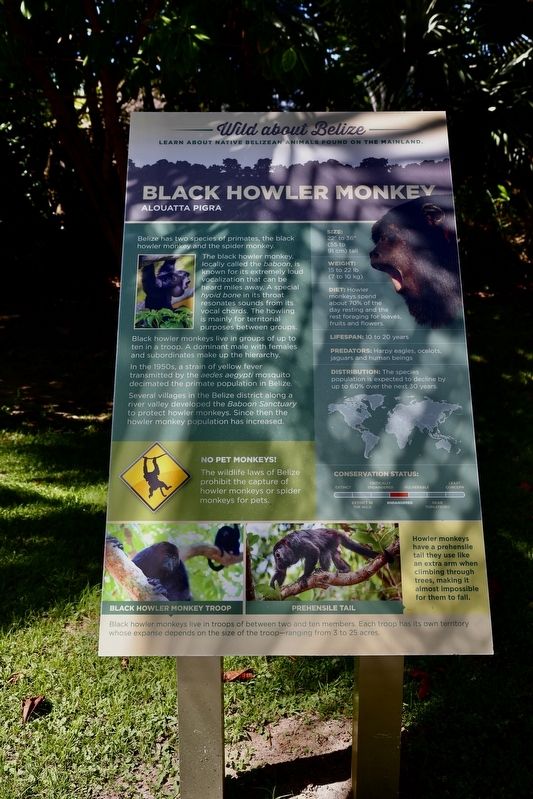Harvest Caye, Toledo, Belize — Central America
Black Howler Monkey
Alouatta Pigra
Inscription.
Black Howler Monkey
Alouatta Pigra
Belize has two species of primates, the Black Howler Monkey and the Spider Monkey. The black howler monkey, locally called the baboon, is known for its extremely loud localization that can be heard miles away. A special hyoid bone in its throat resonates with sounds from its vocal cords. The howling is mainly for territorial purposes between groups.
Black howler monkeys live in groups of up to ten in a troop. A dominant male with females and subordinates make up the hierarchy.
In the 1950s, a strain of yellow fever transmitted by the Aedes aegypti mosquito decimated the primate population in Belize. Several villages in the Belize district along a river valley developed the Baboon Sanctuary to protect howler monkeys. Since then the howler monkey population has increased.
No Pet Monkeys!
The wildlife laws of Belize prohibit the capture of howler monkeys or spider monkeys for pets.
Size: 22" to 36" (55 to 91 cm)
Weight: 15 to 22 lb (7 to 10 kg)
Diet: Howler monkeys spend about 70% of the day resting and the rest foraging for leaves, fruit, and flowers.
Lifespan: 10 to 20 years
Predators: Harpy eagles, ocelots, jaguars, and human beings.
Distribution: The species population is expected to decline by up to 60% over the next 30 years.
Captions
Black Howler Monkey Troop
Black Howler Monkeys live in troops of between two and ten members. Each troop has its territory whose expansion depends on the size of the troop-ranging from 3 to 25 acres.
Prehensile Tail
Howler monkeys have a prehensile tail they use like an extra arm when climbing through trees, making it almost impossible for them to fall.
Topics. This historical marker is listed in these topic lists: Animals • Environment.
Location. 16° 28.635′ N, 88° 24.294′ W. Marker is in Harvest Caye, Toledo. The marker is along the beach in the tree lines. Harvest Caye is a private island in Belize. Touch for map. Touch for directions.
Other nearby markers. At least 3 other markers are within walking distance of this marker. Dugout Canoe (within shouting distance of this marker); Antillean Manatee (about 90 meters away, measured in a direct line); Hawksbill Turtle (about 90 meters away).
Also see . . . Black Howler Monkeys in Belize: Conservation, Habitat, and Tourism. Black howler monkeys, also known as the baboon, are the largest and loudest monkeys in Belize. They can be found throughout the country in rainforests, nature reserves, and other forested areas. However, like many other species, the black howler monkey is facing a number of threats, including habitat loss, poaching, and the illegal pet trade. (Submitted on January 26, 2024, by Sandra Hughes Tidwell of Killen, Alabama, USA.)
Credits. This page was last revised on January 29, 2024. It was originally submitted on January 26, 2024, by Sandra Hughes Tidwell of Killen, Alabama, USA. This page has been viewed 45 times since then. Photo 1. submitted on January 26, 2024, by Sandra Hughes Tidwell of Killen, Alabama, USA. • J. Makali Bruton was the editor who published this page.
